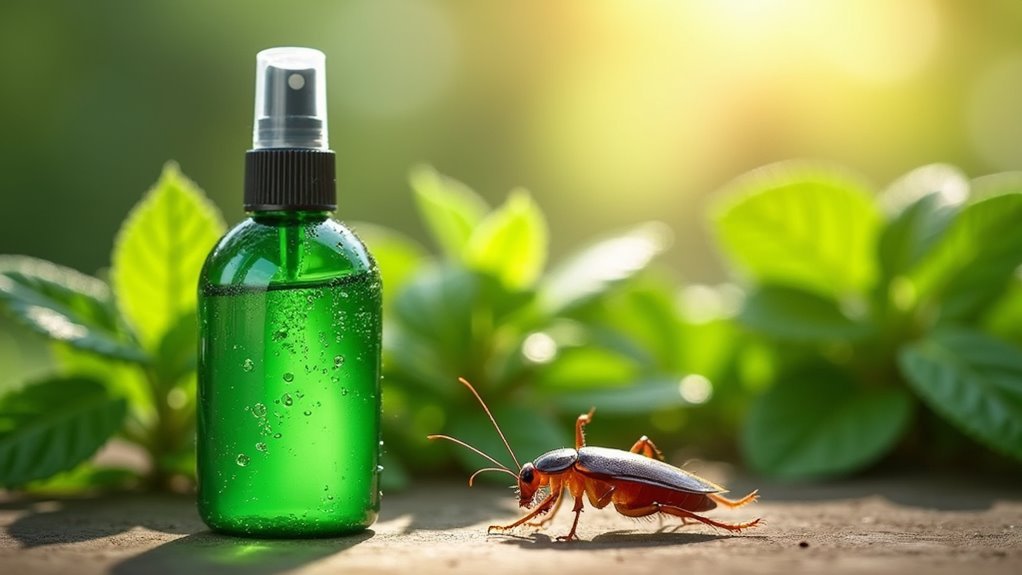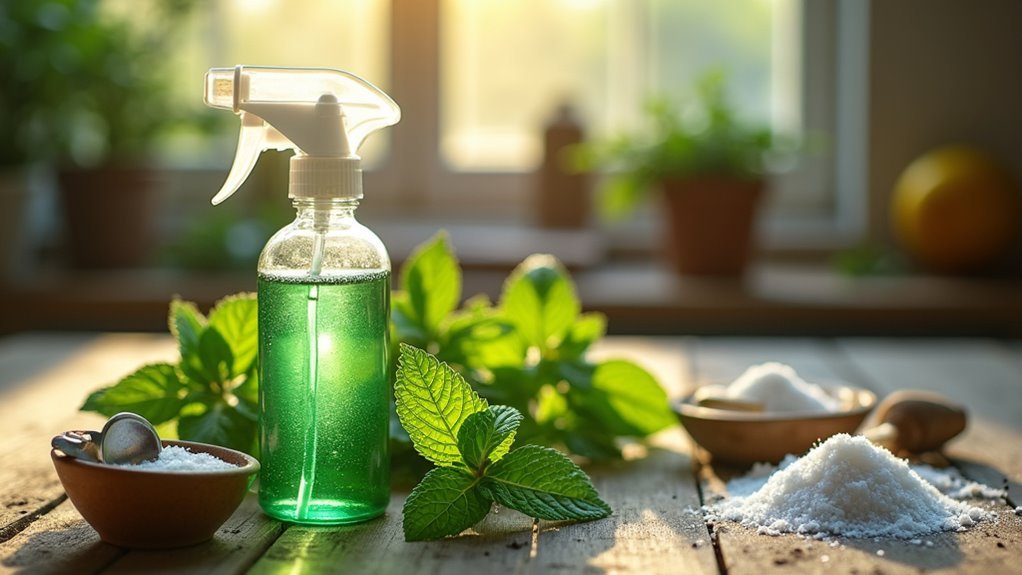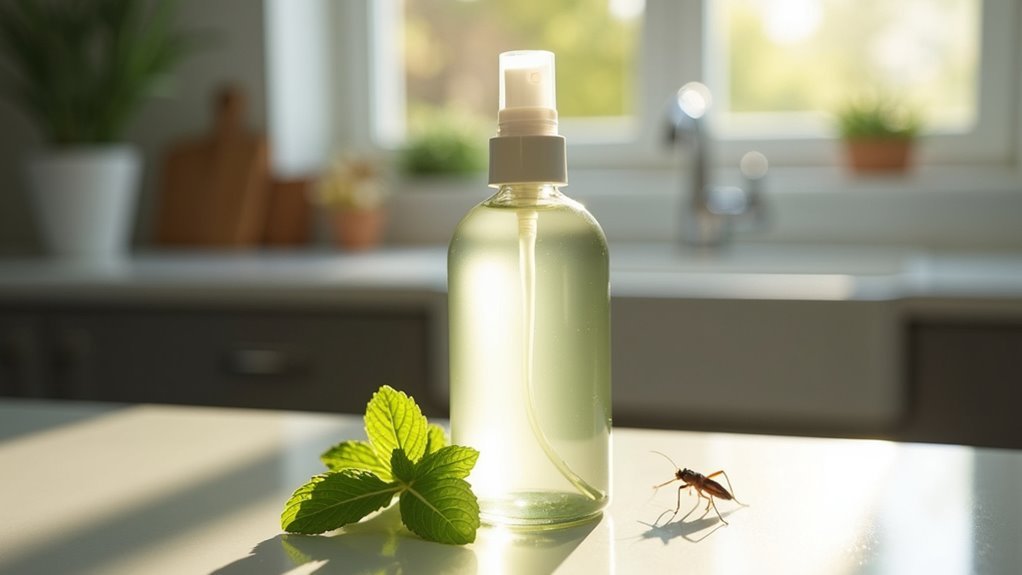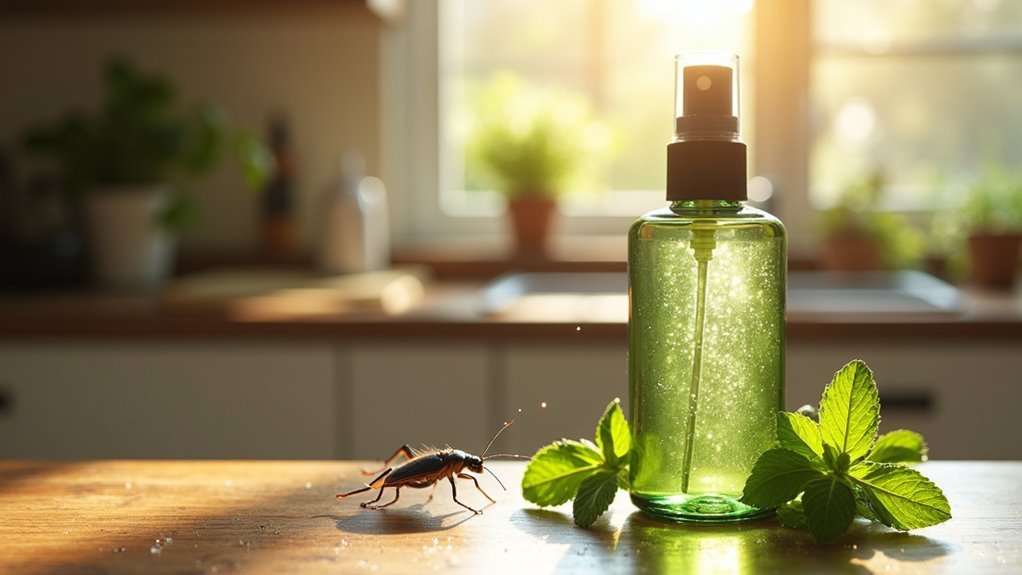You can create an effective natural roach deterrent by mixing 10-15 drops of 100% peppermint essential oil with one cup of water, or enhance it with white vinegar using a 1:3 ratio. The high menthol concentration overwhelms cockroach olfactory receptors, disrupting their navigation and communication. Spray target areas like cracks, crevices, and entry points every 2-3 days, focusing on kitchens and bathrooms where roaches congregate. This thorough approach will maximize your pest control success.
Why Peppermint Oil Overwhelms Cockroach Senses

When you’re dealing with unwanted cockroaches, peppermint oil disrupts their world through sheer sensory overload. The high concentration of menthol creates an overwhelming scent that bombards cockroach olfactory receptors, making treated areas unappealing to these pests.
Cockroaches rely heavily on their advanced sense of smell for survival, using scent to navigate and communicate through pheromones. Peppermint oil’s intense, penetrating aroma masks these critical chemical signals, leaving cockroaches confused and disoriented.
This sensory interference explains why peppermint oil can effectively repel cockroaches from your space. Research confirms that essential oils like peppermint disrupt insect sensory perception, creating an invisible barrier that cockroaches actively avoid.
While it won’t kill them, peppermint oil’s potent scent serves as a powerful natural deterrent that keeps these unwanted visitors away.
Essential Ingredients for Maximum Roach Deterrence
While peppermint oil forms the backbone of your natural roach deterrent, combining it with complementary ingredients creates a more powerful defense system.
Start with 100% peppermint essential oil as your primary weapon—its concentrated formula delivers the strongest scent disruption to cockroach olfactory senses.
Enhance effectiveness by mixing peppermint oil with white vinegar, which amplifies the repelling properties while adding cleaning power.
Alternatively, combine it with Listerine mouthwash for an extra antimicrobial boost that roaches find particularly offensive.
For best results, use 10-15 drops of peppermint essential oil per cup of your chosen base liquid. This concentration guarantees you’ll effectively repel roaches without wasting ingredients.
Remember that highly concentrated mixtures provide longer-lasting protection, reducing your reapplication frequency while maintaining consistent pest control.
Step-by-Step Mixing Guide for Potent Peppermint Spray

You’ll achieve maximum roach-repelling power by getting your essential oil ratios exactly right—typically 10-15 drops per cup of water.
Proper mixing techniques guarantee the oil disperses evenly throughout your spray, while understanding storage requirements will keep your solution potent for weeks.
Let’s break down each critical step so you can create the most effective peppermint deterrent possible.
Essential Oil Ratios
Creating the perfect peppermint roach spray requires precise oil-to-water ratios for maximum effectiveness.
You’ll want to follow these specific measurements to guarantee your essential oil mixture delivers ideal pest-repelling power:
- Standard Water Mixture: Combine 10-15 drops of pure peppermint oil with 1 cup of distilled or boiled water.
- Enhanced Vinegar Solution: Mix 1 part peppermint oil with 3 parts vinegar for stronger repellent properties.
- Cleaning Solution Boost: Add several drops of essential oil to your existing natural cleaners.
- Reapplication Schedule: Refresh your spray every 2-3 days as the scent diminishes.
Remember to shake your bottle gently before each use since oils and water don’t naturally combine.
This guarantees proper distribution throughout your mixture.
Proper Mixing Techniques
Four essential steps will transform your peppermint oil into a powerful roach-repelling spray that maximizes potency while guaranteeing proper distribution.
First, combine 10-15 drops of pure peppermint oil with one cup of distilled or boiled water in your spray bottle. This ratio creates the perfect balance between effectiveness and safety.
Second, choose a spray bottle equipped with a fine mist nozzle to ensure even application across target surfaces.
Third, shake the mixture gently before each use. This vital step guarantees the peppermint oil and water blend thoroughly, preventing separation that weakens the solution’s repellent properties.
Finally, apply generously to cracks, crevices, and entry points where roaches typically enter. Reapply every few days to maintain peak deterrent strength as the scent naturally fades.
Storage and Shelf Life
Proper storage determines how long your peppermint roach spray remains effective, so keep it in a cool, dark location away from direct sunlight and heat sources.
Store your homemade solution in a spray bottle to maintain potency and extend its usable period. Your peppermint spray’s shelf life typically lasts up to two weeks, but you can maximize effectiveness by following these storage guidelines:
- Refrigerate for extended shelf life – Cold storage considerably prolongs the spray’s potency beyond the standard two-week period.
- Shake gently before each use – This guarantees the peppermint oil distributes evenly throughout the water solution.
- Monitor for separation or scent changes – These signs indicate declining effectiveness and signal it’s time for a fresh batch.
- Use fine mist spray bottles – They provide better distribution and preserve the mixture longer.
Target Areas Where Roaches Hide and Enter

When applying natural peppermint roach spray, you’ll want to focus on the specific areas where these pests typically hide and gain access to your home.
Target dark, moist locations like under sinks, behind appliances, and within cracks or crevices where roaches commonly shelter. Apply peppermint oil around entry points including gaps near windows, doors, and plumbing to keep cockroaches from entering.
Don’t overlook storage areas containing cardboard boxes or food items, as these attract nesting roaches.
Treat outdoor spaces like patios where food debris accumulates, and regularly inspect garbage bins and recycling containers. These high-risk zones require consistent attention since roaches gravitate toward them.
Proper Application Techniques for Best Results
You’ll achieve the best results by focusing your peppermint spray application on high-traffic roach areas like kitchens, bathrooms, and entry points.
Apply the spray directly onto roaches when possible, as this method proves more effective than indirect spraying around general areas.
Reapply your peppermint solution every few days to maintain its deterrent strength and create consistent protection against these unwanted pests.
Target High-Traffic Areas
Since passive spraying won’t effectively deter roaches, you’ll need to apply your peppermint oil spray directly onto the insects and in the high-traffic areas where they’re most active.
Focus your efforts on these key locations to maximize your spray’s impact:
- Cracks and crevices – Spray generously into gaps where roaches hide during daylight hours.
- Baseboards and entry points – Create robust barriers along walls and doorways they frequently traverse.
- Kitchen and bathroom corners – Target areas near water sources and food preparation zones.
- Behind appliances – Reach spaces under refrigerators, stoves, and dishwashers where roaches congregate.
Use a fine mist nozzle for better coverage and penetration into hard-to-reach spaces.
This targeted approach with peppermint oil guarantees you’re creating an effective roach-free environment.
Reapplication Frequency Guidelines
Maintaining your peppermint spray’s effectiveness requires consistent reapplication every few days to keep the deterrent scent strong enough to repel roaches.
You’ll need to spray more frequently after cleaning or moisture exposure, as these factors weaken the peppermint oil’s potency. Focus your reapplication efforts on high-traffic areas like cracks, crevices, and entry points where you’ve spotted roach activity.
If you’re using other peppermint oil methods like soaked cotton balls, stagger their replacement with your spray schedule to maintain continuous coverage.
Monitor your home’s roach activity closely – if you notice insects returning after a few days, increase your application frequency immediately. The key is never letting the peppermint scent fade completely, as gaps in coverage allow roaches to return and reestablish their presence.
Direct Vs Indirect Spraying
When should you spray directly versus indirectly for maximum roach elimination? The method you choose determines your success rate with peppermint oil spray.
Direct spraying delivers immediate results when you spot cockroaches, while indirect application helps keep roaches away from treated areas. Passive spraying alone won’t achieve the elimination you’re seeking.
For peak effectiveness, follow these application techniques:
- Target visible roaches – Spray directly onto insects for instant elimination
- Treat entry points – Apply to cracks, crevices, and doorways where roaches enter
- Focus on hiding spots – Concentrate on areas with high roach activity
- Reapply consistently – Refresh treatment every few days to maintain deterrent properties
You’ll notice significant bug reduction within days when combining both direct spraying and strategic indirect application.
Cotton Ball Placement Strategy for Extended Protection
Strategic placement of peppermint oil-soaked cotton balls transforms your home into a fortress against roaches.
You’ll want to saturate cotton balls with pure peppermint oil until they’re damp but not dripping. Focus on high-traffic roach areas like under sinks, behind appliances, and near garbage bins where these pests commonly travel.
Don’t overlook entry points – stuff soaked cotton balls into cracks and crevices where roaches might squeeze through. Distribute them throughout multiple rooms for extensive coverage.
Strategic placement in entry points and multiple rooms creates comprehensive coverage that blocks roach access throughout your entire home.
You’ll need to refresh the peppermint oil every few days to maintain that strong scent that keeps roaches away.
Combine this strategy with other peppermint-based methods you’ve already implemented for maximum effectiveness against these unwanted invaders.
Peppermint-Infused Cleaning Solutions That Repel While You Clean
Combining your regular cleaning routine with peppermint oil creates a dual-action approach that eliminates grime while sending roaches running for the exits. This potent solution merges a few drops of peppermint oil with water and vinegar, creating an effective cleaner that doubles as a natural deterrent.
Here’s your step-by-step cleaning strategy:
- Mix fresh each session – Combine peppermint oil, water, and vinegar for maximum potency.
- Target high-traffic surfaces – Clean kitchen countertops and bathroom floors thoroughly.
- Focus on entry points – Apply solution along baseboards and potential roach pathways.
- Create lasting barriers – Regular use maintains an unwelcoming environment that continues to repel roaches.
The strong peppermint aroma combined with vinegar’s disinfecting properties eliminates odors while establishing protective zones throughout your home.
Vacuum Bag Enhancement Method for Ongoing Deterrence
Your vacuum cleaner becomes a powerful roach-deterrent tool with one simple addition: peppermint-soaked cotton balls placed directly in the vacuum bag.
Drop a few drops of pure peppermint oil onto a cotton ball or tissue before inserting it into your vacuum bag. As you clean, the vacuum disperses the peppermint scent throughout your home, naturally repelling cockroaches and other unwanted pests while freshening the air.
This dual-action approach means you’re simultaneously cleaning and keeping them away from treated areas.
Ascertain the cotton ball doesn’t block airflow and verify compatibility with your vacuum model.
Replace the peppermint-soaked materials regularly to maintain potent scent levels and consistent deterrent effectiveness against roaches throughout your cleaning routine.
Creating Peppermint Pest Strips for Problem Areas
You can create targeted peppermint pest strips by soaking cloth strips or sticky traps in a concentrated peppermint oil and water solution until they’re fully saturated.
Place these strips strategically in high-roach activity zones like baseboards, behind appliances, and near garbage areas where cockroaches typically travel and hide.
This method lets you focus your natural deterrent efforts on specific problem spots while maintaining a chemical-free approach to pest control.
Strip Preparation Methods
When roach activity concentrates in specific areas of your home, peppermint pest strips offer a targeted solution that delivers concentrated deterrent power exactly where you need it most.
These strip preparation methods guarantee maximum effectiveness:
- Mix the solution: Combine pure peppermint oil with water in proper proportions for ideal potency.
- Saturate thoroughly: Soak strips or sticky traps completely until they’re fully absorbed with the peppermint mixture.
- Distribute evenly: Ensure peppermint oil spreads uniformly across each strip’s surface for consistent scent coverage.
- Strategic placement: Position prepared strips along baseboards, crevices, and near garbage bins where you’ve spotted roach activity.
You’ll need to refresh the strips every few days to maintain their repelling properties and monitor their effectiveness regularly.
Strategic Placement Tips
Effective placement transforms your peppermint pest strips from simple deterrents into powerful roach-fighting tools.
You’ll maximize your peppermint oil’s impact through strategic placement in high-traffic roach areas. Position strips under sinks, behind appliances, and near garbage bins where cockroaches frequently travel. Target dark, damp locations since these environments attract roaches naturally, increasing strip contact likelihood.
Create extensive coverage by placing multiple strips throughout your space rather than relying on single locations. Focus on areas where you’ve spotted roach activity or droppings previously.
Kitchen cabinets, bathroom corners, and basement storage areas make excellent strip locations. Remember that strategic placement means thinking like a roach—they prefer hidden pathways along walls and beneath furniture where they feel protected while foraging.
Safety Guidelines for Homes With Pets and Children
Although peppermint oil spray offers a natural solution for roach control, you’ll need to take specific precautions when using it around pets and children.
Peppermint oil can be toxic to dogs and infants, making safety measures crucial.
Follow these guidelines to protect your family:
- Apply in well-ventilated areas and guarantee complete drying before allowing pets and children access to treated surfaces.
- Monitor pets closely for allergic reactions or adverse effects, as individual sensitivities vary greatly.
- Store products securely out of reach to prevent accidental ingestion or misuse by curious children and pets.
- Clean treated surfaces regularly to minimize residue buildup that could pose ongoing risks to household members.
These precautions guarantee effective pest control while maintaining a safe environment.
Reapplication Schedule for Continuous Effectiveness
Since peppermint oil’s effectiveness diminishes over time, you’ll need to establish a consistent reapplication schedule to maintain continuous roach control.
Apply the spray every few days in high-activity areas where you’ve spotted roaches most frequently. Focus on direct application rather than passive spraying for maximum impact.
Target high-activity roach zones with direct spray application every few days for maximum effectiveness rather than random spraying.
Environmental factors affect your reapplication schedule considerably. High humidity, pets, and children require more frequent applications to maintain potency.
You’ll see noticeable population reductions within days when you’re consistent with timing.
Track your application dates to guarantee ideal effectiveness. Mark your calendar or set phone reminders to avoid gaps in treatment.
This systematic approach prevents roaches from returning and maintains the deterrent effect throughout your home’s problem areas.
Cost Comparison With Chemical Alternatives
Natural peppermint roach sprays like Mighty Mint cost $19.98 for a 16oz bottle, which appears more expensive than conventional chemical pesticides at first glance.
However, you’ll discover significant long-term savings when considering the complete cost picture.
Here’s why peppermint oil delivers better value:
- Reduced repurchasing frequency – Unlike chemical sprays requiring constant reapplication, natural alternatives last longer between treatments.
- DIY solution – You’ll avoid expensive professional pest control service calls that chemical pesticides often necessitate.
- No health-related costs – Chemical alternatives can create long-term health risks, potentially leading to medical expenses.
- Persistent effectiveness – While results may vary, many users find peppermint oil more cost-effective than recurring chemical treatments for ongoing infestations.
You’re investing in safety and sustained effectiveness rather than quick fixes.
When to Combine Peppermint Oil With Professional Treatment
While peppermint oil works effectively for many roach problems, you’ll sometimes need to combine it with professional treatment for best results.
If you’re seeing frequent roach sightings despite consistent peppermint oil application, it’s time to call in professional pest control to assess your infestation’s severity.
You should consider professional intervention when peppermint oil doesn’t produce satisfactory results after several weeks of regular use.
Combining both approaches creates a multi-faceted strategy that addresses severe infestations with targeted treatments while leveraging peppermint oil’s natural repellent properties.
After professional pest control completes their treatment, continue using peppermint oil as a preventive measure.
This complementary strategy helps maintain a pest-free environment by deterring any roaches attempting to return to your home.
Frequently Asked Questions
Does Peppermint Actually Repel Roaches?
Yes, peppermint oil does repel roaches by overwhelming their olfactory senses. You’ll find it works as a natural deterrent, though it won’t kill them and requires regular reapplication for continued effectiveness.
What Is the Best Homemade Spray to Kill Cockroaches?
You’ll get the best results mixing 10-15 drops of pure peppermint oil with one cup of distilled water. For enhanced killing power, you can add vinegar or Listerine to boost effectiveness.
What Is the Best Natural Cockroach Repellent?
You’ll find peppermint oil is the best natural cockroach repellent. Its strong scent deters roaches effectively without harmful chemicals. Apply it directly to insects and reapply every few days for ideal results.
What Do You Mix Peppermint Oil With to Make a Spray?
You’ll mix peppermint oil with distilled water using 10-15 drops per cup. For stronger effectiveness, you can combine it with vinegar or Listerine instead of plain water.
In Summary
You’ve got a powerful, natural weapon against roaches that won’t harm your family or pets. Mix your peppermint spray fresh, target those sneaky hiding spots, and reapply consistently for best results. While it’s incredibly effective for prevention and minor infestations, don’t hesitate to call professionals if you’re dealing with a serious cockroach problem. You’ll save money, protect your home naturally, and keep those unwanted guests away for good.





Leave a Reply